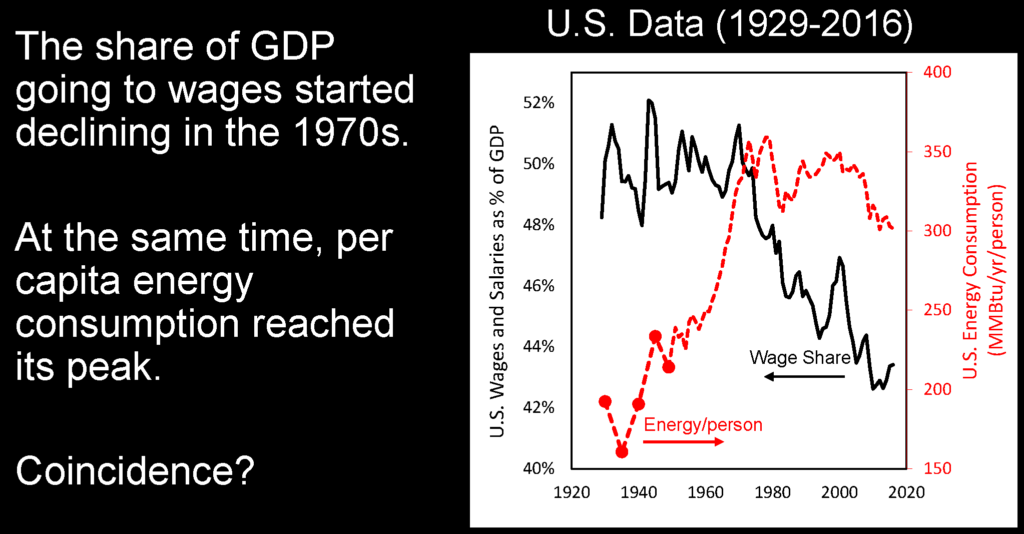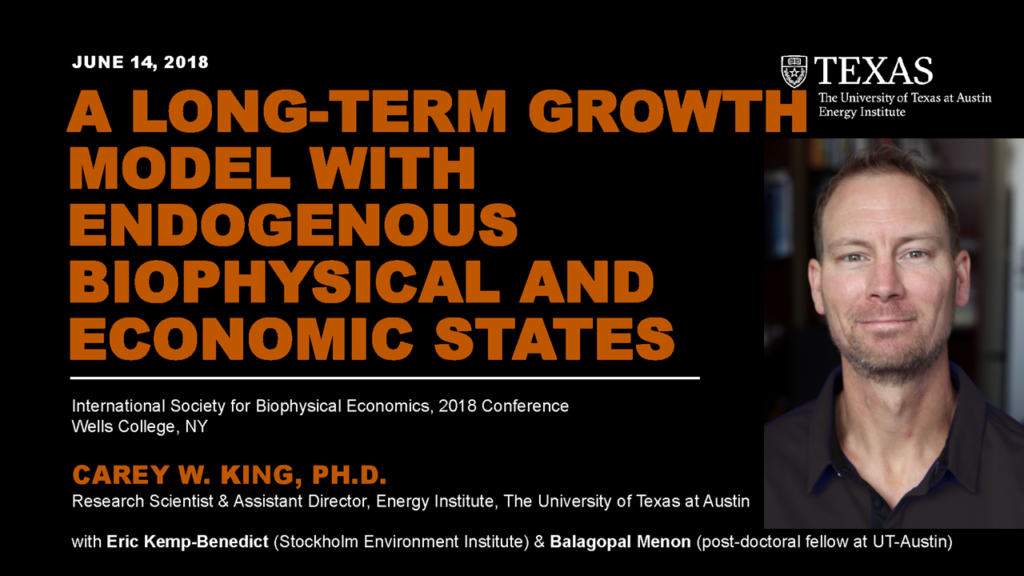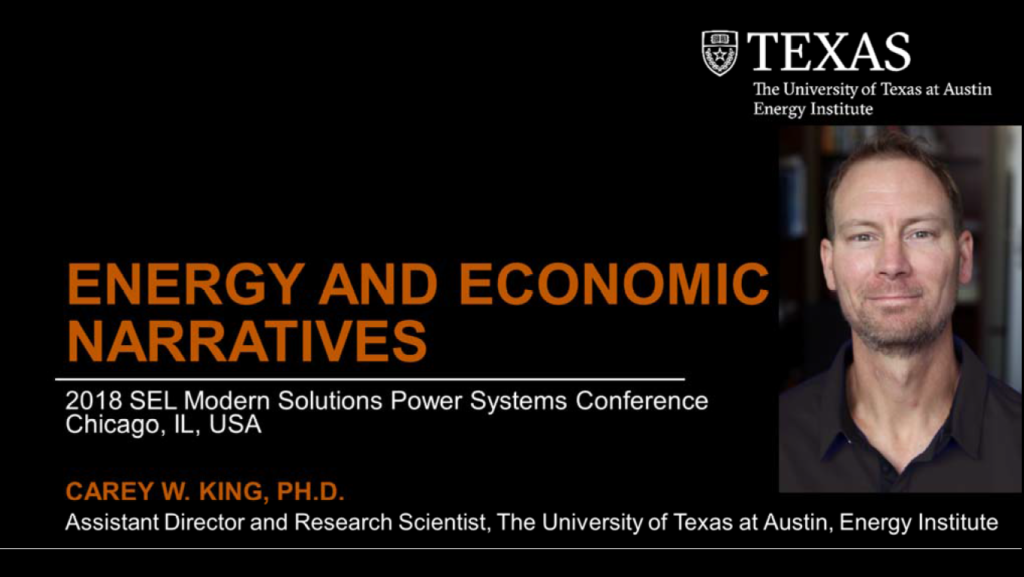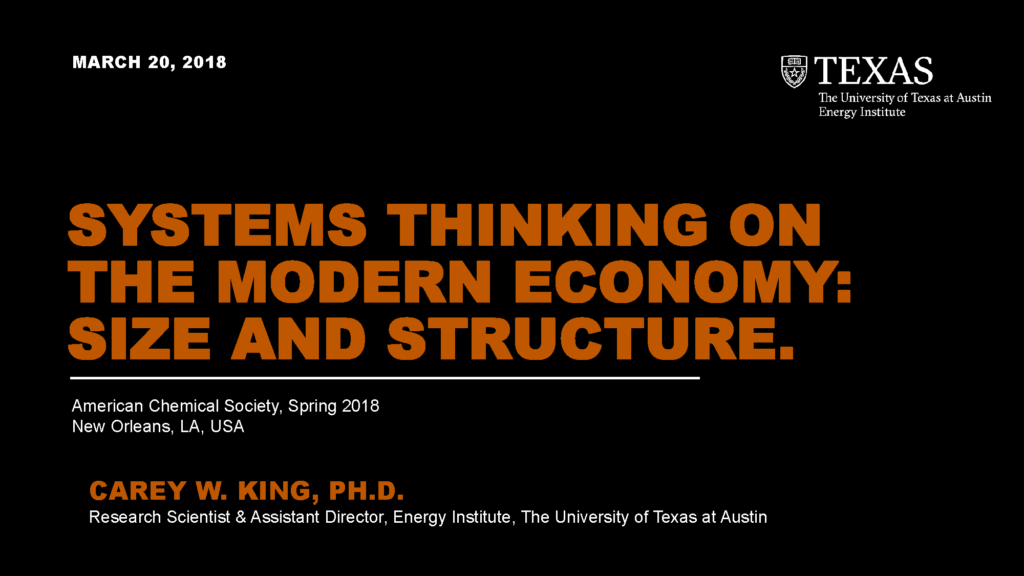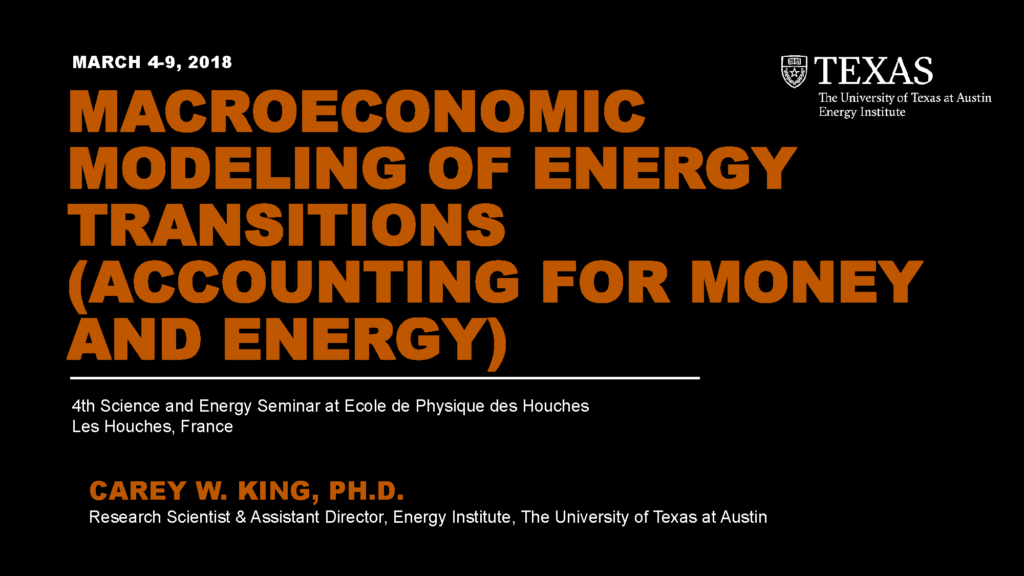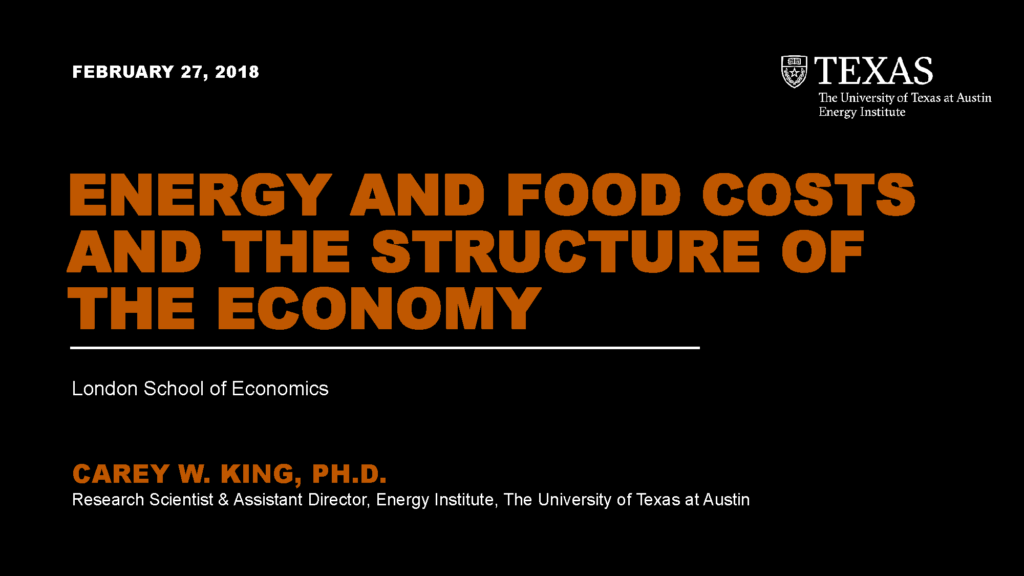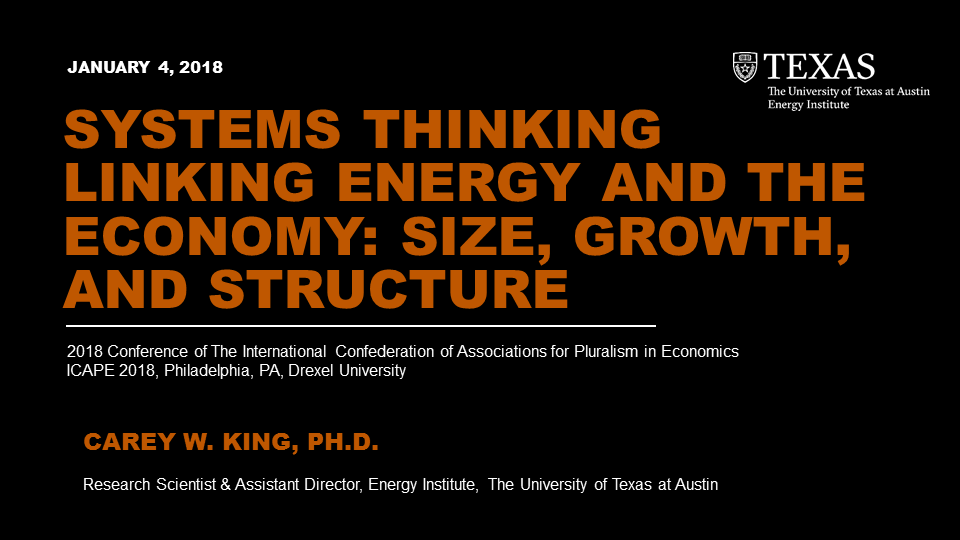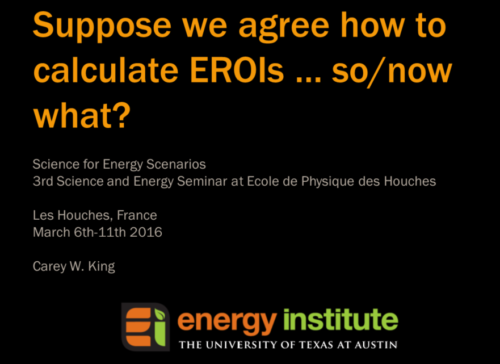2022
September 19, 2022 (Video): Insights and Questions from HARMONEY, a Biophysical Economic Growth Model (Fields Institute, Toronto, ON, Canada)
This talk was part of a Workshop on Impacts of Climate Change on Economics, Finance, and Insurance. I highlight some of the insights we can gain from my modeling approach for understanding energy and economic patterns.
May 26, 2022 (Video): The Economic Growth Modeling We Need (INET @ Oxford)
This talk for the Institute for New Economic Thinking at the University of Oxford Martin School discusses the major insights of my 2022 paper in Biophysical Economics and Sustainability: “Interdependence of Growth, Structure, Size and Resource Consumption During an Economic Growth Cycle“. These insights, from coherently linking a biophysical and economic growth model, are also on a past blog post.
January 10, 2022: The Economic Growth Modeling We Need
Webinar presentation to the International Association for Energy Economics, January 10, 2022.
2021
June 9, 2021: Investigating Decoupling and Structural Dynamics via the “HARMONEY” Biophysical Growth Model (Video)
This is my presentation and video from the International Association for Energy Economics (IAEE) International Conference (online) June 7-9, 2021. In this presentation, I summarize results from my recent paper (in review at the time) on a version 1.1 of my Human and Resources with MONEY (or HARMONEY) model.
2020
November 11, 2020: Can Macroeconomic Models really Model a Low-Carbon Energy Transition?
A discussion with Carey King, Steve Keen, and David Daniels as part of the webinar series of the International Association for Energy Economics.
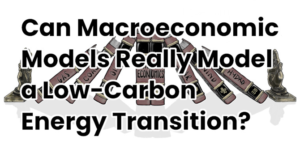 Summary: Are the right theories and assumptions being used to integrate the economics of energy and climate change? Can the current crop of economic models (e.g., IAMs) effectively inform energy and carbon policy? What are the economic theories and assumptions behind these models, and are they up to the task? If not, what economic theories and frameworks can improve our modeling of energy and economic interactions? Join this webinar for insights into the practical and theoretical difficulties and possibilities for modeling the important linkages between energy consumption and economic growth and distribution. (Direct YouTube video link)
Summary: Are the right theories and assumptions being used to integrate the economics of energy and climate change? Can the current crop of economic models (e.g., IAMs) effectively inform energy and carbon policy? What are the economic theories and assumptions behind these models, and are they up to the task? If not, what economic theories and frameworks can improve our modeling of energy and economic interactions? Join this webinar for insights into the practical and theoretical difficulties and possibilities for modeling the important linkages between energy consumption and economic growth and distribution. (Direct YouTube video link)
September 21, 2020: Our Energy Infrastructure: Navigating Choices and Challenges
A webinar for the International Association for Energy Economics, United States Association for Energy Economics, and University of Texas at Austin, Energy Institute. Discussion with Armond Cohen of the Clean Air Task Force, and moderated by Professor Varun Rai of The University of Texas at Austin.
July 21, 2020: Takeaways from Planet of the Humans: A Conversation on Energy and Society with Richard Heinberg
Part of the University of Texas at Austin’s Energy Institute’s “Summer Energy Talks” series
June 24, 2020: “HARMONEY: A Biophysical and Economic Growth Model“, Presentation at the Thermodynamics 2.0 Conference of the International Association for the Integration of Science and Engineering
April 18, 2020: “A Journey to Understand Relationships Between Energy and the Economy” Presentation to the Engineers for a Sustainable World DigiCon20 Conference
2019
December 13, 2019: Presentation of the HARMONEY economic model to the System Dynamics Society Economics Special Interest Group: Video Link
March 14, 2019: “Economic models need biophysical principles: Otherwise we can’t explain our energy past or future“
This presentation was part of the University of Texas at Austin Energy Institute‘s Energy Symposium speaker series. It is an introduction to how physical principles can be invoked to understand our economy as a system that can be described by how it consumes energy. I discuss why focusing on the physical flow of energy through networks and machines helps us make improved macroeconomic models and frameworks that are more explanatory and insightful than the standard neoclassical economic growth model.
2018
November 18, 2018: “Is there a link between Wages and Energy Consumption?“
This was a presentation at the Southern Economic Association Conference, November 2018 in Washington, DC.
In this (32 minute) talk I provide a much more concrete description of my macroeconomic model linking natural resources to economic dynamics. I describe the sequence of events that describe how natural resources consumption is linked to macroeconomic trends such as population growth, capital investment, debt, and wages. This is the most complete description of the results to date, and it builds on the other presentations (given in 2018) on the same topic.
See here for the white paper describing the research behind this presentation: https://papers.ssrn.com/sol3/papers.cfm?abstract_id=3334615.
June 14, 2018: “A Long-term Growth Model with Endogenous Biophysical and Economic States“
Video link, Download presentation
This presentation discusses a macroeconomic model that integrates biophysical variables (people, natural resources (energy), capital) to economic variables (wages, debt, profits, interest payments, employment). This modeling framework can be used to understand and model long-term energy transitions and resource-economic feedbacks.
This was a talk given at the 2018 Conference of the International Society for Biophysical Economics (www.isbpe.info), Wells College, Aurora, NY. This is a longer and updated version of a similar talk given in France in March, 2018.
June 7, 2018: “Energy and Economic Narratives“
Video link, Download presentation
Presentation at the 2018 Schweitzer Engineering Laboratories Modern Solutions Power Conference, Chicago, Illinois.
March 20, 2018: “Food, Energy & Water Resources and Economy: Evidence for Biophysical & Social Constraints on Society”
A full-day session arranged for the 255th American Chemical Society Meeting in New Orleans, Louisiana.
A summary of each speaker, talk title, and abstract are listed below:
- Carey W. King (Research Scientist and Assistant Director, Energy Institute, University of Texas at Austin), “Systems Thinking Linking Energy and the Economy: Size and Structure” Download slides
- Julie Hoggarth (Baylor University, Department of Anthropology), “Tales from the Past: Indicators of Ancient Maya Societal Structures during the ‘Classic Maya Collapse‘” Download Slides
- Charles Hall, (retired, College of Environmental Science and Forestry, State University of New York, Syracuse, NY), “Biophysical Economics: History and Uses”
- Andrew Jarvis (Lancaster Environment Center, Lancaster University, UK) , “Accretaxis: the regulation of the growth of the global economy”, Download Slides
- Joseph R. Burger (Post-doctoral fellow, Department of Biology, University of North Carolina, Chapel Hill, USA & North Carolina Museum of Natural Sciences, Raleigh, USA), “Extra-metabolic energy use and the rise in urban hyper-density” Download Slides
- Garvin Boyle (Independent Researcher, Orrery, Software, Richmond, Ontario, Canada) “Distributional Social Justice: Insights From a Doubly-Bounded Capital Exchange Model” Download slides
- Daniel Urban (PhD Candidate, Department of Economics, University of Missouri Kansas City, Kansas City, USA) “The Production Boundary & Empirical Constructs: The Implicit Foundations of National Accounting” Download slides
- Nathan Schaffer (Partner, Groppe, Long, and Littell, Houston, TX) “U.S. Unconventional Resource Development – A Lesson Learned in Time” Download slides
March 20, 2018: “Systems Thinking on the Modern Economy: Size and Structure“
Presentation at the 255th ACS National Meeting & Exposition of the American Chemical Society, New Orleans, LA, USA (the 2018 Spring Meeting of the American Chemical Society).
March 4-9, 2018: “Macroeconomic Modeling of Energy Transitions (Accounting for Money and Energy“
Video Link & Presentation download
Presentation at the 4th Science and Energy Seminar at Ecole de Physique des Houches, March 4th-9th, 2018.
February 27, 2018: “Energy and Food Costs and the Structure of the Economy“
Presentation at the London School of Economics.
January 4, 2018: “Systems Thinking Linking Energy and the Economy: Size, Growth, and Structure“
Presentation at the 2018 conference of ICAPE (The International Confederation of Associations for Pluralism in Economics).
2017
December 15, 2017: “Energy and the Economy over the Long-Term: Size and Structure”
Weekly seminar of the Bureau of Economic Geology: http://www.beg.utexas.edu/node/4038
Video (direct link):
http://streaming.beg.utexas.edu/Geology/Play/4179ce7b278b4771be8e6faaff03dd6a1d
Abstract: A long-term and systems-oriented perspective on the role of energy resources and technologies shows that they play a fundamental role in enabling the physical and economic growth of the Industrial era. Yet, most economic modeling approaches do not even consider that energy availability and constraints fundamentally affect the size and structure of our economies. This lack of energy-economic coupling means that most economic frameworks cannot even consider the energy system as an explanatory factor for the Great Recession and the economic “secular stagnation” since 2008. In addition, mainstream economic frameworks cannot explain future implications of large scale changes in the energy system (e.g., a low-carbon transition), even though they are used for this purpose. This presentation shows data to make the case that (1) the declining cost of energy (including food) is an apt explanation for historical growth, (2) worldwide energy and food costs reached the lowest point in history around the year 2000, and (3) the cessation of the decline in energy and food costs (within the U.S.) helps explain structural changes within the U.S. economy.
February 2017: Webinar Summary of the Energy Institute’s “Full Cost of Electricity” Study, for the Center for Next Generation Photovoltaics
Webinar video: https://www.youtube.com/watch?v=NUiF3WwKLe4
2016
March 6-11, 2016: Science for Energy Scenarios conference, France, March, 2016
Suppose we agree how to calculate EROIs … so/now what?, Science for Energy Scenarios, the
3rd Science and Energy Seminar at Ecole de Physique des Houches, Les Houches, France, March 6th-11th 2016. See conference link: http://science-and-energy.org/slides-videos/.
Video (~ 60 minutes): https://www.youtube.com/watch?v=R9GGmGYIcS8
Presentation (with notes): link
March 2016: Masaryk University, Czech Republic
Summary of Carbon Capture and Storage research, pilots, and economics in the United States (presentation).
2015
Energy and its Relation to Complexity of the Economy, Granada Seminar 2015: Physics Meets the Social Sciences, La Herradura, Spain, June 15, 2015.
Energy, Economy, and Efficiency, presentation for the UT Quest (Opportunities for Learning) program, Austin, TX, April 23, 2015.
Long-term Energy and Economic Trends: Pre-Industrial to Today, presentation for the CleanTX Lunch series, Austin, TX, February 10, 2015.
2014
Energy-Water Nexus, Texas Water Law Institute Conference, November 19-21, 2014, Austin, TX.




